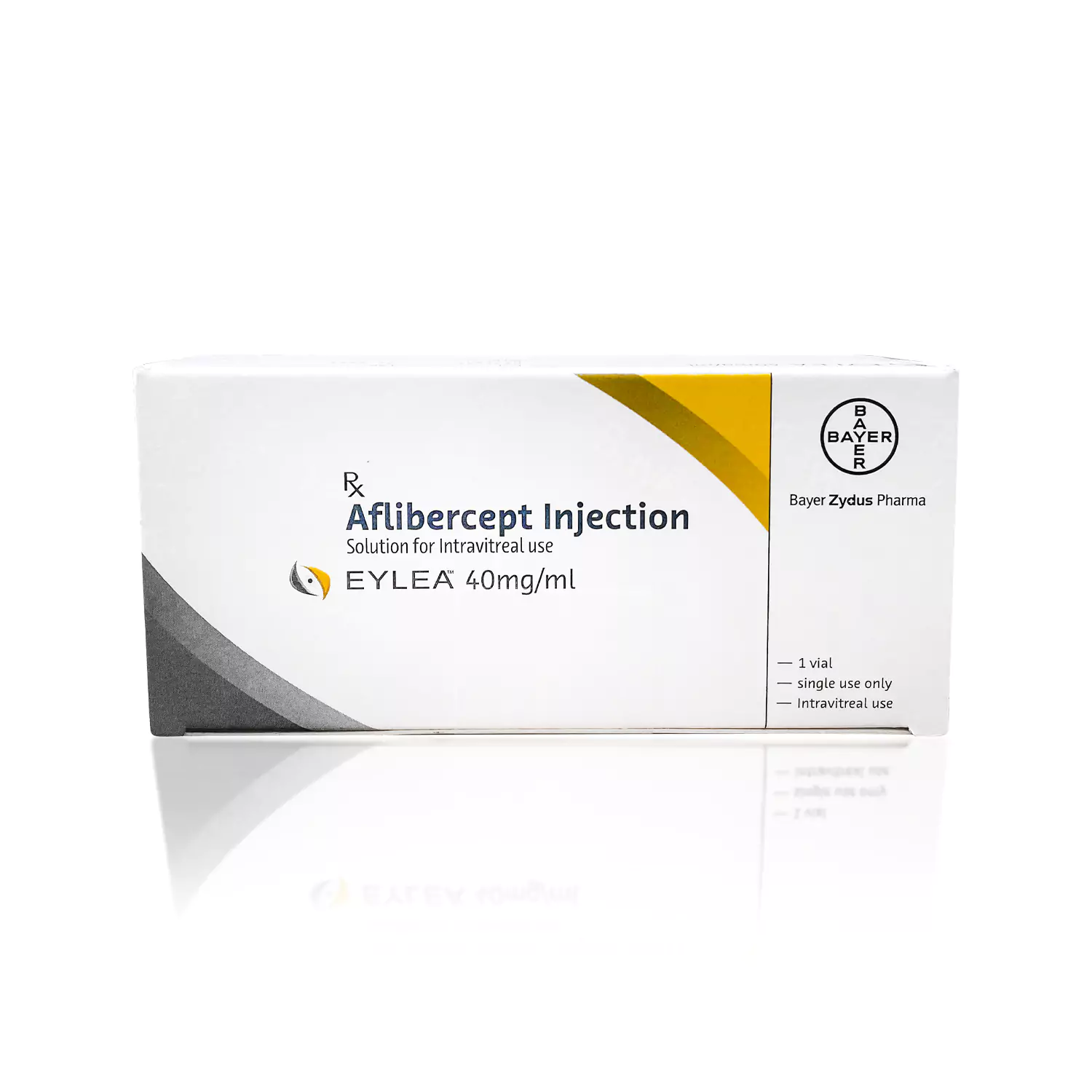EYLEA® Indications for Use
EYLEA® (aflibercept) is a vascular endothelial growth factor (VEGF) inhibitor used for treating various retinal conditions by inhibiting abnormal blood vessel growth and leakage. It is specifically indicated for:
- Neovascular (Wet) Age-Related Macular Degeneration (AMD).
- Macular Edema following Retinal Vein Occlusion (RVO).
- Diabetic Macular Edema (DME).
- Diabetic Retinopathy (DR).
- Retinopathy of Prematurity (ROP) in infants.
These conditions typically involve abnormal growth of blood vessels or fluid accumulation in the retina, which EYLEA effectively manages.
EYLEA® Dosage Information
EYLEA is administered via intravitreal injection, directly into the eye by a qualified ophthalmologist.
- Wet AMD:
- Initial dose: 2 mg every 4 weeks for the first 3 months.
- Maintenance dose: 2 mg every 8 weeks after 3 months.
- Some patients may require dosing every 4 weeks.
- Macular Edema Following RVO:
- Recommended dose: 2 mg every 4 weeks.
- DME and DR:
- Initial dose: 2 mg every 4 weeks for the first 5 injections.
- Maintenance dose: 2 mg every 8 weeks.
- ROP in Infants:
- Recommended dose: 0.4 mg via intravitreal injection.
- Injections may be given bilaterally on the same day, with a minimum interval of 10 days between doses in the same eye.
EYLEA is available as 2 mg/0.05 mL solutions in pre-filled syringes or single-use vials.
EYLEA® Side Effects and Precautions
As with any intravitreal injection, EYLEA carries risks of both common and serious side effects:
- Common Side Effects (≥5%):
- Conjunctival hemorrhage.
- Eye pain.
- Cataracts, vitreous floaters, and increased intraocular pressure.
- Serious Side Effects:
- Endophthalmitis, a serious infection inside the eye.
- Retinal detachment.
- Retinal vasculitis, with or without vascular occlusion.
- Increased intraocular pressure within 60 minutes of injection.
Precautions:
- Patients with ocular or periocular infections, or active intraocular inflammation, should not receive EYLEA.
- Monitoring is essential for patients at risk of arterial thromboembolic events (ATEs), such as nonfatal stroke and myocardial infarction. Studies have shown an incidence of 1.8% in patients treated for AMD and 3.3% for DME patients.
EYLEA® Clinical Studies or Real-World Outcomes
Multiple clinical trials have demonstrated the efficacy of EYLEA in managing retinal diseases:
- Neovascular (Wet) Age-Related Macular Degeneration (AMD):
- Two pivotal studies, VIEW1 and VIEW2, included 2412 patients.
- EYLEA showed 94-95% of patients maintaining visual acuity (fewer than 15 letters lost) after 52 weeks. Improvement in Best Corrected Visual Acuity (BCVA) by an average of 7.9-10.9 letters was observed in those treated every 4 or 8 weeks.
- Macular Edema Following RVO:
- In the COPERNICUS and GALILEO studies, 56-60% of patients gained at least 15 letters in BCVA after 24 weeks of treatment with EYLEA compared to 12-22% of patients on placebo.
- Diabetic Macular Edema (DME) and Diabetic Retinopathy (DR):
- The VIVID and VISTA trials enrolled 862 patients, demonstrating a significant improvement in BCVA by 10-12.5 letters over the course of 52 weeks compared to 1.2 letters in the control group.
- Retinopathy of Prematurity (ROP):
- Studies including BUTTERFLEYE and FIREFLEYE showed efficacy in preterm infants, with 6-9% of treated infants experiencing retinal detachment, a serious but rare adverse event.
EYLEA® Drug Interactions
There are no significant drug interactions known for EYLEA; however, care must be taken to avoid its use in combination with other VEGF inhibitors due to increased risk of systemic adverse effects like thromboembolic events.
- No specific dosage modifications are required based on renal function, age, or gender.
- Special caution should be exercised in patients with a history of stroke or heart attack, as they may be at higher risk for thromboembolic events.
EYLEA® Summary of Benefits
EYLEA offers significant clinical benefits for patients with a range of retinal conditions, providing long-term improvement in visual acuity and reducing the need for more invasive treatments. Its key benefits include:
- Vision Preservation: Over 90% of patients with AMD maintain vision after 1 year of treatment.
- Visual Improvement: Increases in BCVA were noted across all major studies, with gains of 7-12 letters in retinal disease patients.
- Flexible Dosing: After the initial loading phase, patients can be treated every 8 weeks, reducing the burden of frequent injections without compromising efficacy.
- Cardiovascular Risk Reduction: Lower risk of major thromboembolic events compared to other therapies.
EYLEA® Key Ingredients and Mechanism of Action
EYLEA’s active ingredient is aflibercept, a recombinant fusion protein. It acts as a VEGF inhibitor, blocking the action of VEGF-A and placental growth factor (PlGF), two proteins responsible for promoting abnormal blood vessel growth and leakage in retinal diseases.
- Aflibercept binds VEGF-A and PlGF, preventing them from interacting with their receptors on endothelial cells. This action reduces neovascularization and vascular permeability, thereby stabilizing or improving visual acuity in affected patients.
EYLEA® Recommended Treatment Protocol
EYLEA is administered as an intravitreal injection:
- Preparation: Aseptic technique is critical. Inspect the solution before injection to ensure no cloudiness or particulates are present.
- Dosage: Administer 2 mg for most conditions, except in ROP, where 0.4 mg is used.
- Follow-Up: Monitor for signs of increased intraocular pressure, retinal detachment, or infection immediately after injection.


